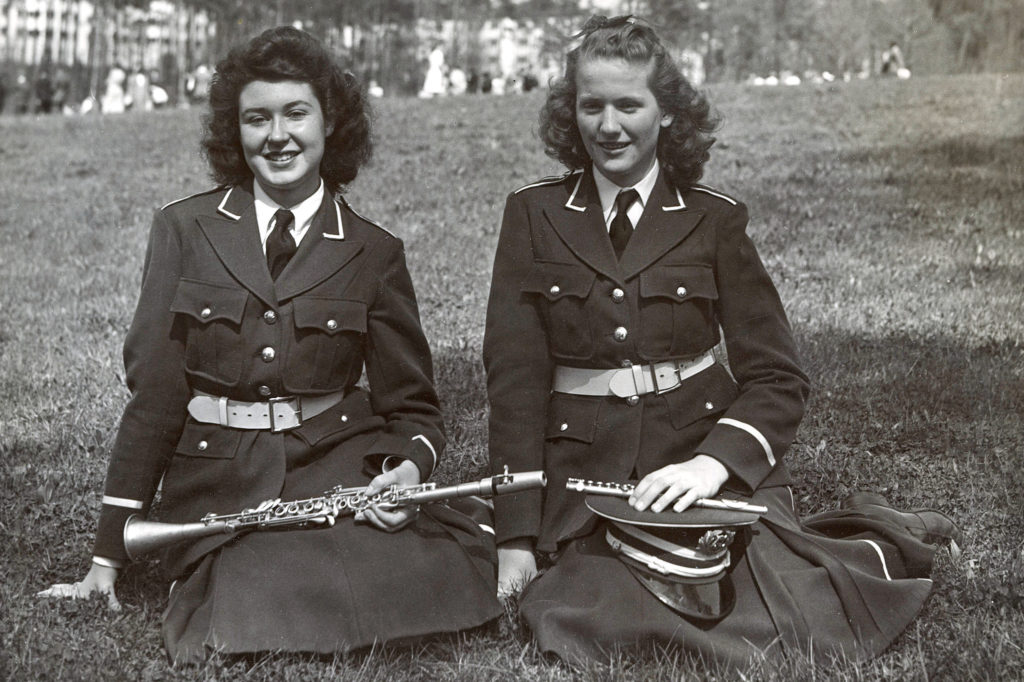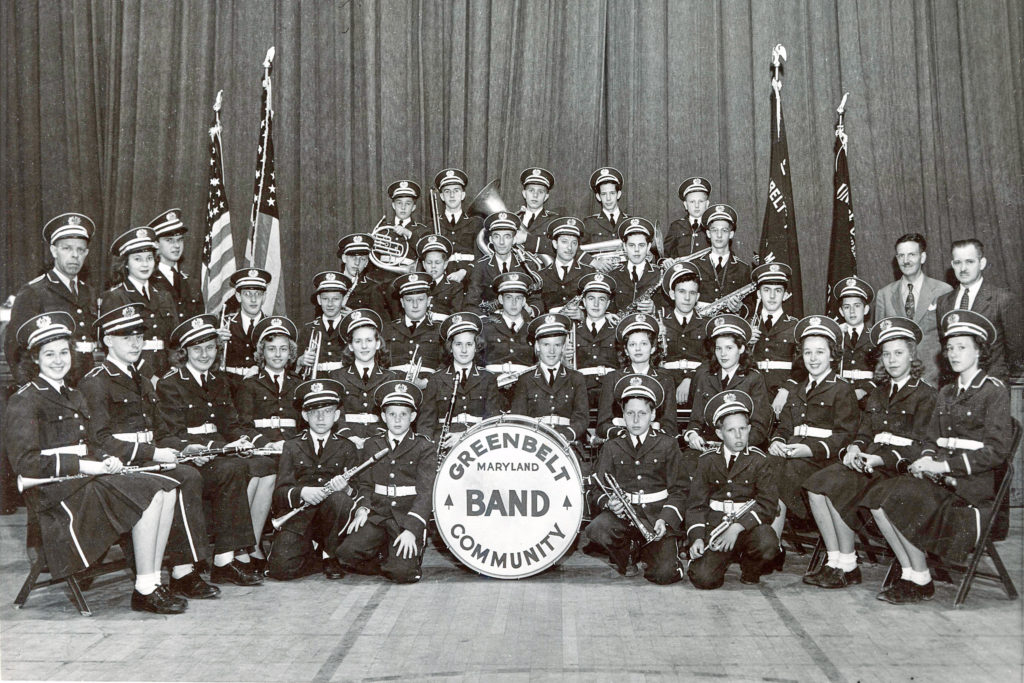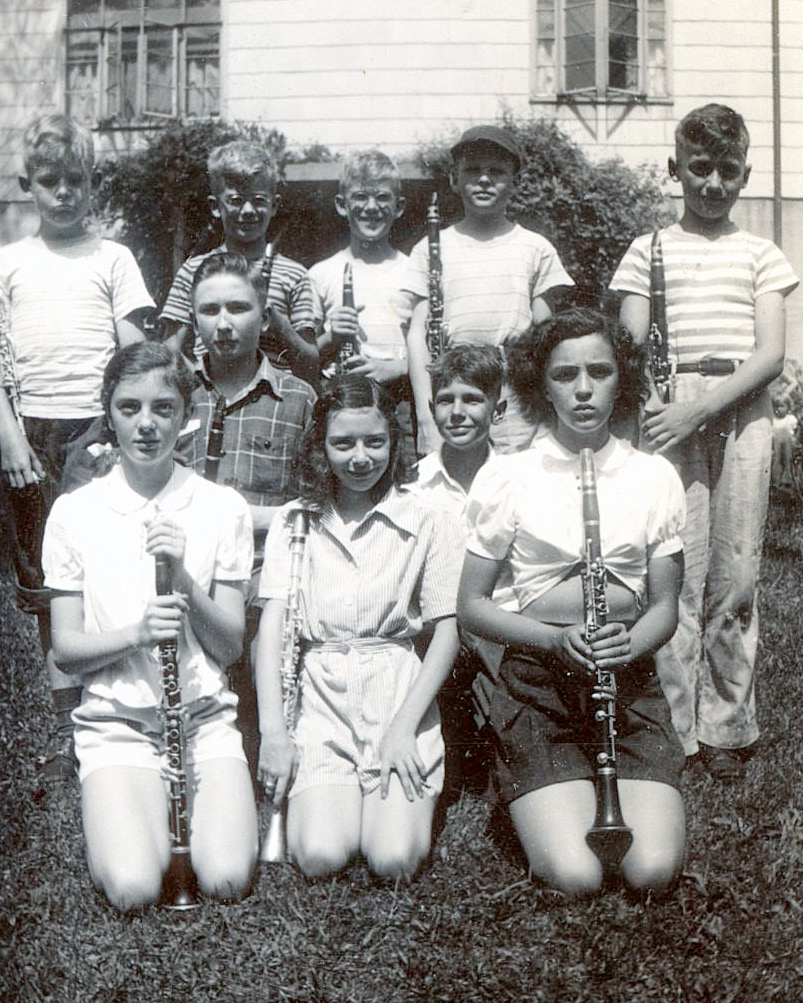Once upon a time there was a town, built by the government as a planned community, surrounded by woods far away from Washington. A town a classmate once called the “Emerald City,” where the town leaders formed a band for young people, ages 12 through high school. The town was Greenbelt and the year was 1940 and I was lucky enough to be part of the original Greenbelt Community Band.
The band was carefully planned. Instruments were obtained from surplus stocks belonging to military bands. Notices went out in the town’s newspaper, the Greenbelt Cooperator, for young people who wished to learn to play an instrument to attend a meeting at Center School (now our Community Center). A young musician and educator, Paul T. Garrett, was hired to be the conductor of the band. He interviewed the applicants and assigned each one to an appropriate instrument. A Parents Board was established to set up rules and make sure the children attended each practice. I was given a little wooden E-flat clarinet.
Most of the members of this new band had never before played an instrument. Many, like me, didn’t know the difference between a trombone and a flute. But, unlike the band in The Music Man (still my favorite movie), we didn’t use the “think system.” Mr. Garrett, our teacher and leader, was the son of a bandmaster and had been a clarinetist in the National Symphony Orchestra. Although his own expertise was with the clarinet, he knew how to play every instrument. He taught each person how to blow and how to finger their flute, clarinet, cornet or trombone. Each player had to learn how to play the scale and how to read music. Our practices were held in the auditorium of Center School every Friday night. Soon there came a night when he gave the signal for all of us together, to play just one assigned note, all at once. Out came the most beautiful sound I had ever heard!
Our first performance as a band was at a small church in Washington. Mr. Garrett had written by hand the music of simple hymns for each instrument. Soon we graduated to marches, then overtures. By February of 1942 we were a real band, with new uniforms. We played several marches at a Defense Rally held at Center School. First Lady Eleanor Roosevelt was the main speaker. After the program was over, Mrs. Roosevelt asked Mr. Garrett to line up all the band members so she could shake hands with each one of us. (I wrote about this occasion in the News Review of March 5, 1992, page 13.)
With the coming of World War II, our band underwent many changes. The older members were graduating from high school. The boys were going into military service, including those who played the larger instruments like tuba and the big horns. Some of the younger members switched from clarinet and cornet to take their places. I remember especially that Mahlon Eshbaugh, the first-chair clarinet player, switched to the sousaphone. I was asked to give up my little one-of-a-kind E-flat clarinet and was promoted to take Mahlon’s place as head of the regular B-flat clarinet section. A “Feeder Band” was started, to teach younger children who wanted to join the band.
By 1943, even our leader, Paul Garrett, had left to serve as an officer in the Navy. He sent his brother, Dana Garrett, to be the new band conductor. Dana was an accomplished cornetist; he had toured the world with the renowned Sousa Band. Dana’s first task was to ready the Feeder Band members for entry into the “big” band. He asked several of us original members to help him by giving private lessons to some of the younger players. I gave clarinet lessons on Saturdays in my basement at 7-K Crescent Road, and my friend Pat Brown taught flute to several younger members, including Shirley Morrison, the mayor’s daughter.
Under Dana Garrett’s leadership, the band grew and flourished. We performed at summer concerts on the lawn of Center School and at the water carnivals in the swimming pool, and at all the town’s civic events. In 1944 and ’45, Pat and I even wrote a column for the Cooperator called Toots, which reviewed the weekly concerts. As we improved musically, Dana worked on our marching and showmanship skills. As the finale for one concert, Pat stood to play the piccolo obligato for the final chorus of Stars and Stripes Forever while I took the baton to lead the band and the whole cornet section stood and marched around to the front of the stage.
Pat and I were active in the band all through high school and beyond, but we were not there for the band’s real “glory years” of the 1950s, when majorettes were added and trophies were won. Pat went on to the University of Maryland and joined their band, and was the flute soloist for the University’s orchestra. I attended Trinity College and worked as a secretary for USDA in Beltsville. Pat was killed in an auto accident shortly before her graduation with honors from the University. She died on Easter Sunday 1949, two weeks before my marriage to Henry McFarland.
Greenbelt Concert Band
By 1960, all the high schools had their own bands and the Greenbelt Community Band had come to an end. But some of the young people wished to continue playing music as adults; there was enthusiasm for an adult band in Greenbelt. With encouragement and support from the city fathers, the Greenbelt Concert Band was formed. A meeting was held at Center School for those interested. Donald Smith, leader of the High Point High School band, conducted the meeting. A few of us former members of the old Community Band showed up. I even got my husband to come for a few practices – but he already played in his polka band on weekends. George Townsend, whose father had been a leader of the U.S. Navy Band, was the flute player. “Butch” Domchick, retired from the Army Field Band, came. But the only clarinet players at first were Steve Polaschik and me – and we really needed a whole clarinet section. A small band of Greenbelters was formed, and I played with them at several concerts; I especially remember one at the Springhill Lake center building, with a young man named Howard Carle leading the band. But eventually I had to drop out to care for my growing family.
Several years later, when John Del Homme became leader, the city gave permission to open up the Concert Band to a broader population. The band’s full name became Greenbelt Concert Band of Prince George’s County. Many new players joined, some of them NASA employees or veterans of military bands. The Concert Band flourished under Del Homme’s leadership for many years, and later with Tom Cherrix as leader.
Today’s Greenbelt Concert Band, now led by Joan Rackey, claims their beginnings in 1940. That’s true in a way, the main difference being that the 1940 Greenbelt Community Band was made up of children and teenagers living in Greenbelt. Now the Greenbelt Concert Band is an adult band, still based in Greenbelt and open to all. The spirit is the same, as claimed in the banner the Concert Band displays: A Tradition of Musical Excellence since 1940.



